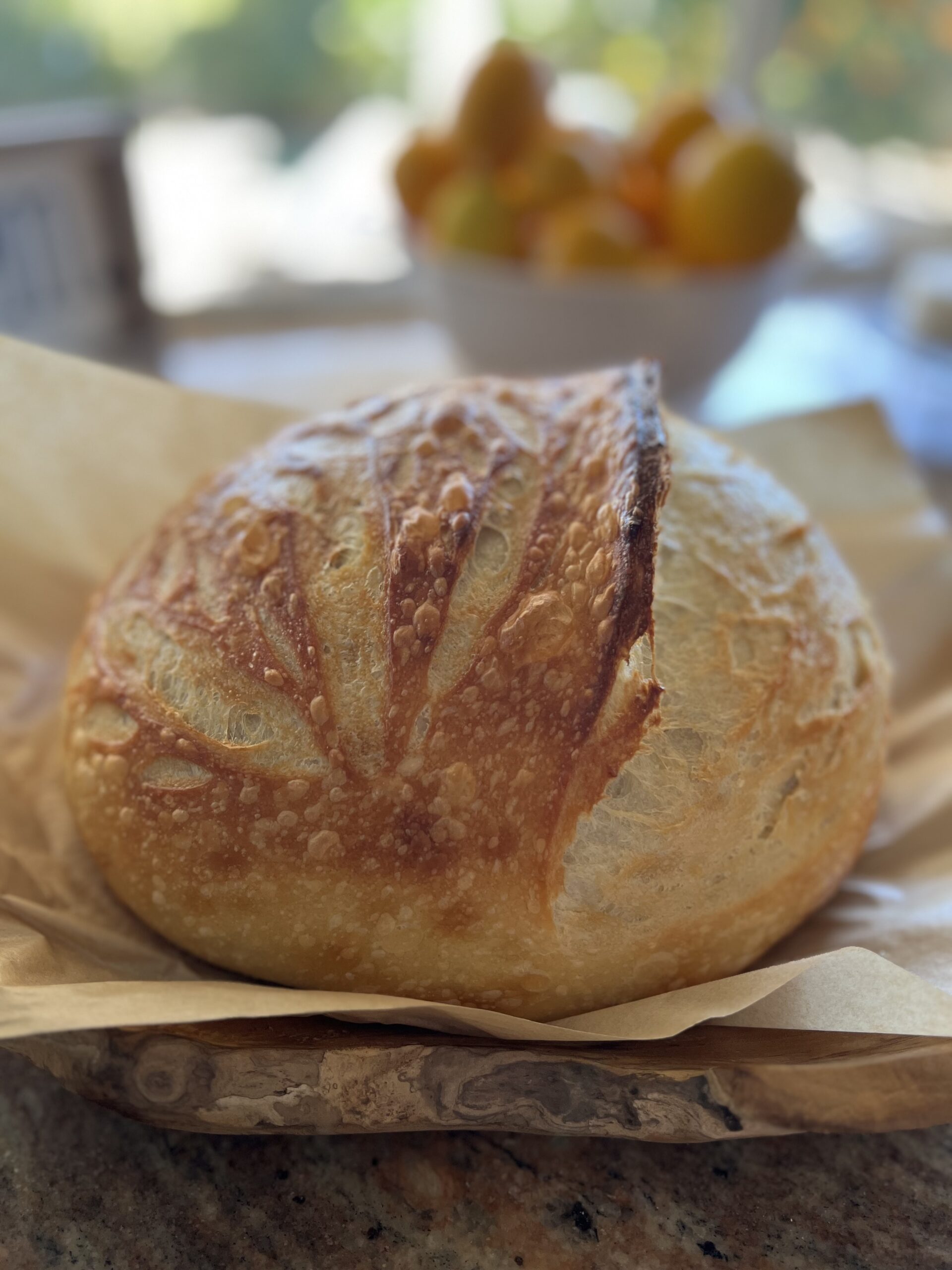Crusty Sourdough Bread

Sourdough bread is such a wonderful treat, and the best part is that you only need a handful of simple ingredients! But it’s not just about the ingredients; it’s all about the science, a little patience, and some practice. It’s truly a labor of love that makes it taste so delicious. Once you try making it at home, you’ll never want to go back to store-bought again!
BAKING TIPS:
FEEDING YOUR STARTER
Once your starter is nice and bubbly, feel free to give it a little love every day if you’re planning to bake some delicious bread! If not, no worries—you can pop it in the fridge and just feed it once a week. Just remember, before you start baking, give your starter a few extra feedings (2-3 times) to get it all recharged and ready to go!
No worries if you forget to feed your starter, need a break, or if you have a vacation planned! It’ll be just fine in the fridge for a few weeks without being fed.
When I’m ready to bring my starter back to life and make it nice and strong, I love using a simple 1 to 1 to 1 ratio (1:1:1)! That means I combine equal parts of water, flour, and starter. It’s super easy! Just grab a clean jar and a scale, and measure each ingredient the same. Don’t forget to zero out the scale after each measurement. For example, you can use 100 grams of water, followed by 100 grams of flour, and then 100 grams of starter. Once your starter is nice and strong, you can return to your regular feeding routine.
KITCHEN SCALE VS CUP MEASUREMENT
I recommend getting a kitchen scale! It makes measuring flour and water so much easier and more accurate than using cups. I was a bit nervous about it at first, but I quickly realized how simple it is. Oh, and remember the best tip: always zero out the scale before you add your next ingredient.
BREAD STORAGE
Keep your bread fresh by storing it in an airtight bag for up to 5 days! After a day or two, I find that sourdough bread is especially tasty when toasted. If your bread gets a bit too hard, don’t worry! You can quickly transform it into breadcrumbs or delicious croutons.
Did you know you can freeze your bread before it gets tough? Just pop it into an airtight bag, and it’ll be good for up to 3 months! You can freeze the whole loaf or slice it up first. If you slice it before freezing, it’s super easy to grab just a few slices when you want some toast or a quick sandwich. Enjoy your fresh bread anytime!
BAKING SCHEDULE
How long does it take?
I typically like to make the dough in one day. I then refrigerate overnight and bake off first thing the next morning. So, a two-day process. Your times depend on how fast your starter rises. If it’s colder then it might take longer to rise. If that’s the case you might want to feed your starter as early as possible to give it enough time to rise.
Here is an example of my schedule:
Day 1
- 9 AM Feed sourdough starter.
- 1 PM If your starter looks ready, mix water, starter, flour, and salt. Cover for 1 hour.
- 2 PM First stretch and fold. Cover and let rest for 30 minutes. Repeat three times.
- 2:30 PM Second stretch and fold. Cover and let rest for 30 minutes.
- 3 PM Third stretch and fold. Cover.
- 3 PM Bulk ferment at room temperature for 2-3 hours.
- 5-6 PM Final shape. Cover with plastic and let rest for 30 minutes.
- 6-7 PM Place in fridge to cold ferment until ready to bake.
- Sometimes I’ll let it sit on the counter a little longer and place it in the fridge around 9 pm.
Day 2
- 8 AM Score and bake.
WHAT IS SOURDOUGH CRUMB?
Sourdough crumb is the inside texture. It should have an even consistency, meaning there won’t be any dense areas with giant holes. It should be light and fluffy – not wet or gummy. The holes inside the sourdough may seem shiny. This is a sign that the gluten is very well developed.
Open crumb is generally more sought after than closed crumb when it comes to sourdough. However, closed crumb will make a great loaf for sandwiches.
WHAT ARE INCLUSIONS?
Inclusions are the ingredients you add to your dough. It can be savory or sweet. There are lots of different ingredients you can add. Here are a few delicious ideas.
•Rosemary, roasted garlic and parmesan
•Jalapeño and cheddar or my absolute favorite- jalapeno and Monterey jack cheese.
•Caramelized Onions and Cheese
•Lemon Blueberry
•Milk Chocolate Chips
•Kalamata Olive
•Roasted Garlic, parmesan, red pepper flakes, salt, pepper
•Freshly grated parmesan and fresh cracked pepper. Inspired by Cacio e Pepe pasta.
•Cranberry/Walnut
•Muenster cheese
•Cinnamon raisin
•Everything bagel seasoning
•Italian herbs and cheese
•Chedder and chive
•Caramelized onion and cheddar
• Butter (croissant)
TESTING YOUR STARTER
There are a few ways to test your starter! One method I find that works for me is dropping a small amount of starter into a cup of water. If it floats, you know it’s good to go! Give it a try and see how it works for you!
SHOPPING LINKS
I linked my Amazon store below for helpful baking products. Everything is listed under baking goods.
Disclaimer: This page contains affiliate links. If you choose to purchase after clicking a link, I may receive a small commission at no additional cost to you. Thank you for your support!
Crusty Sourdough Bread
Ingredients
- 1 1/2 cups or (350 grams) room temperature filtered water
- 1/2 cup or (100 grams) active sourdough starter
- 3 cups or (500 grams) organic unbleached bread flour
- 2 teaspoons salt
Instructions
STEP 1: FEED YOUR STARTER
- Feed your sourdough starter, and let rise at room temperature on the counter until doubled in size, about 4-6 hours.
STEP 2: PREPARE THE DOUGH
- In a large mixing bowl, whisk together the water and active sourdough starter. You can use a dough whisk or a spatula.Next, add the bread flour, and sea salt to your water starter mix.Mix everything well until you get a shaggy-dough ball. Next, knead your dough for 4-6 minutes until everything is nice and smooth.Let your dough rest for about an hour and a half in a nice warm area on your counter.
STEP 3: STRETCH AND FOLD
- Damp in your hands grab part of the dough stretch it upward without tearing and fold it into its center. Give the ball a quarter turn and repeat this three more times until all sides of the dough have been stretched and folded into the center. Cover your dough with your damp towel and repeat this step every 30 minutes for a total of three stretching folds. With each set, your dough will have more strength. This will help with gluten development.
STEP 4: BULK FERMENTATION (FIRST RISE)
- Leave your dough for approximately 4 to 8 hours on your kitchen counter. If your kitchen is warmer, start checking it after 3-4 hours to make sure it doesn't over-proof.
STEP 5: SHAPE AND SECOND RISE
- Gently turn the dough out onto a lightly floured surface. Sometimes your dough might be a little sticky, so let gravity help, while lightly loosening from the edges. Shape the dough by stretching it into a rectangle then folding the left side over to the middle then repeat on the right side. Start rolling your dough up from the bottom. Next, you will form a ball by cupping, rolling, and pulling to create a nice smooth ball. Transfer your dough seam side up, and smooth side down into a well-flowered Beniton-proofing basket. Cover with a tea towel and let it sit on the counter for two hours depending on how cold your kitchen is. It might need more time to fermentate. After fermentation move to the fridge overnight keeping it covered. I cover my dough with plastic wrap that is pressed nicely against all edges of the ball, or you can use a shower cap. Let this rest in your fridge overnight.
STEP 6: TIME TO BAKE
- Preheat your oven to 450° leave your Dutch oven inside and let it preheat for about 15- 30 minutes.Turn your dough ball on a piece of parchment paper. Dust it lightly with all-purpose flour and smooth the flour out with your hand or brush. Next, you’re going to score your dough. This is when you can create a design with your bread lame. There are so many really cute ways to design your sourdough bread. Pinterest has lots of ideas. For an easier score, you can create a cross shape on the top or a half-moon crescent along the side. Make sure to carefully take out your Dutch oven using oven mitts. Place your dough ball with the parchment paper inside and add an ice cube to the outside of the parchment paper. Close the lid and bake for 30 minutes. After 30 minutes remove the lid and bake for another 15 minutes until your bread has a beautiful golden brown color.Remove your bread and Let it cool before slicing. Please wait at least 1 hour before slicing it into a freshly baked sourdough loaf. Slicing into a warm loaf will cause the bread to become dense and gummy. If you wait until the bread cools before slicing, it will be light and fluffy. Trust me, it's worth the wait!

